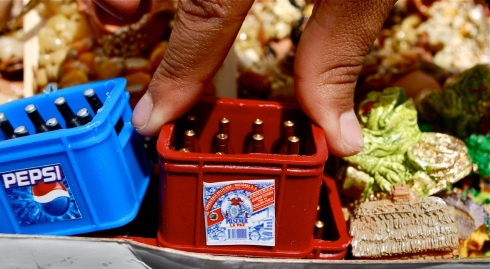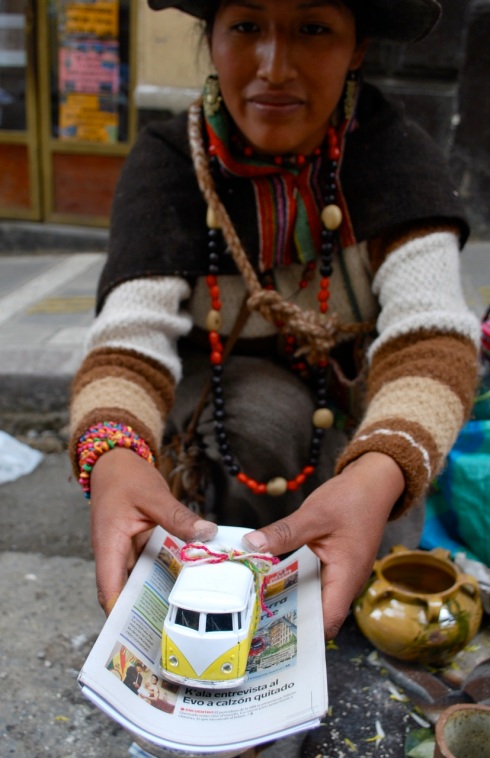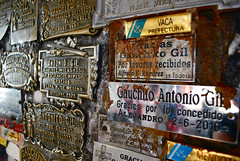Jupapina, La Paz, Bolivia
[by Paula]
I was a bit of a geek for miniatures when I was younger. While others had cool bedrooms crammed with music posters, Pacman games (yes, it was the 80s) and normal teenage paraphernalia, my shelves were lined with tiny little versions of just about anything I could get my hands on. I’d like to say I’d grown up since then…
… but when we heard there was a festival of miniatures in La Paz, I could hardly contain myself. We were there like a shot. We oohed and awwed at all the little things, took a zillion photos and watched aghast as half of La Paz almost stampeded a bunch of Catholic priests in the cathedral.
Not only was I in heaven but I was getting paid for it, as the BBC and MSN Travel had commissioned me to write articles on the festival. Double bonus.
So I’ve been busy writing quite a lot about Alasitas in the last few days. Rather than create another account of the fabulous first day of the festival, I’ve lazily inserted my BBC article into this post. There are also a few more photos below, some of which were included in the MSN Travel slideshow.
The point of Alasitas is that you buy mini versions of all the things you want to come true in the coming year. You may or may not be wondering if we bought anything. It probably goes without saying what was at the top of our shopping list….
—–
BBC News Magazine, 30 January 2014
‘Alasitas: Bolivia’s festival of miniatures’
Bolivia’s Alasitas festival is a bizarre buying frenzy that mixes ancient traditions and beliefs with modern-day religion and consumerism. Thousands turn out to buy everything they want in the coming year, in miniature form, in the hope that the gods will convert their dreams into life-sized reality.
Imagine you could go to the market, buy everything you wanted in the year ahead for just a few dollars and carry it all home in one plastic bag. It might be a new house, a car, a husband or wife, or even a divorce. Or perhaps a suitcase stuffed with cash, a degree from a top university, a new job, a shiny laptop or all the food you can eat?
This is exactly what happens at the Alasitas festival, which runs for a month in La Paz, Bolivia. Everyone is buying small, and dreaming big.
On day one artisans and street vendors fill the plazas and line the pavements throughout the city, loudly hawking tiny wares ranging from finely-crafted miniatures to plastic toy versions of the real thing.
Everything bought is blessed by priests before being offered to a chubby cigarette-puffing Andean god, Ekeko.
Ekeko – the god of abundance – is the key to whether these desires will become reality, many believe. True followers will keep a statue in their home, offering him their miniatures along with a lit cigarette and a few prayers
“When you really believe in it, it becomes real,” says Ana Cossio, 24, an NGO worker from La Paz. “My mum bought me a little marriage certificate at Alasitas. A month later I found out I was pregnant and was married later that year.”
In the city’s Plaza Murillo, teeny suitcases stuffed with piles of mini dollars, bolivianos and euros are stacked on tables. Some even come complete with a full travel package – little cardboard credit cards, passport, airline tickets and visas.
Vendors shout over each other to be heard: “Dollars and euros here! Money, money!”
Shoppers swap real cash for piles of fake money, which is later exchanged with friends, family or strangers in the street, in an act of reciprocity that is ingrained in Andean culture.
They also part with small amounts of cash for mobile phones, computers, flat-screen TVs, DIY tools and every brand of car, truck and minibus imaginable – all in diminutive form. Baby vegetables, tiny sacks of flour and rice, crates of beer and stacks of matchbox-sized supermarket brands are being bought up by the thousands as the festival gets under way.
Miniature houses, office buildings and shops are carefully examined as people browse for their perfect design. Those planning to build their own can buy a mini plot of land, complete with all the building materials they need – tiny bricks, bags of cement, wheelbarrows and spades.
Even all the daily newspapers are printed at a quarter of their normal size, carrying spoof stories about the government and the news of the day.
While money and material goods are hugely popular, Alasitas is also about searching for luck in life – be that in love, work or simply an abundance of food for the family. Ceramic cockerels and hens are bought and exchanged to help friends and loved ones find a partner.
And thousands of little fake certificates are printed and sold – including marriage and divorce documents, degrees, driving licences and professional qualifications.
Brother and sister Rita and Jorge Llanque Torrez are having their purchases blessed by an Andean priest on the steps of La Paz’s main cathedral. Jorge wants a new job in education planning, so has bought himself a ‘certificate of work’, while his sister has high hopes for her teenage daughter.
“I live in Barcelona but my daughter is here in Bolivia. I have bought a visa and passport for her so she can get her papers and come to Spain too. It’s the second year I have bought them for her…” says Rita.
Celebrated in La Paz every January, Alasitas has its origins in an indigenous Aymara harvest festival in which farmers prayed for bountiful crops. Opinions vary as to how and when Ekeko emerged in his modern-day form, but historians say that the concept of exchange and the offering of miniatures to a god of abundance date back to the pre-Inca Tiwanaku culture of Bolivia.
Over the centuries, economic, religious and cultural influences have seen Alasitas transform almost beyond recognition.
A vivid illustration of the blending of traditional indigenous beliefs and Spanish Catholicism happens at midday on day one – the hour when people rush to have their purchases blessed.
“There is an almighty crush. A few broken little houses lie trampled underfoot.”
They offer 96%-proof alcohol to pachamama – mother earth – by sprinkling it on the ground, and wave bags of shopping and handfuls of fake money over the smoke.
But for many people this is not quite enough. They might have faith in the power of Ekeko, but they believe strongly in their Christian god too.
At 11:55am there is a sudden surge towards the entrance of the cathedral. People are carried with the crowd towards the altar, and a gentle hum of voices rises to a roar as the clock approaches noon. There are so many people in the church that the Catholic priests have to bring in extra help. Several of them stand on plinths as the throng pushes towards them, holding their purchases aloft.
“Padre! Padre! Over here!” they shout, frantically waving fistfuls of miniatures and cash. In an attempt to rapidly bless as many things as possible the priests dip bunches of flowers in holy water flinging it over the crowd in great arcs.
“It’s not very Catholic,” says Ana Cossio. “I think the priests allow it because they can’t control it.”
As the first wave tries to exit the cathedral there is an almighty crush. A few broken little houses lie trampled underfoot.
The crowd is somehow expelled from the church into the packed plaza, where hundreds of people are shopping and eating. While opening day is the most chaotic and frenzied of the festival, this cycle of spending, exchanging and hoping goes on for a month.
Alasitas is at once a frivolous, serious and, at times, contradictory fixture of the Bolivian calendar. Modern day scenes of flashing wads of cash at a priest may barely resemble a traditional harvest festival, but it could be seen as a window on the shifting desires of a nation that is rapidly changing and developing, while proudly holding on to its traditional culture.
ALASITAS: A BRIEF HISTORY
- Indigenous Aymara event originally called Chhalasita before Spanish colonial times – involved simple exchange of basic goods. The Spanish changed the name from its original meaning of ‘exchange me’ to ‘buy me’.
- Evolved to adopt elements of Catholicism and Western desire to accumulate material wealth.
- In 1781 the date was changed to 24 January, to commemorate an indigenous uprising and to give thanks to Catholic saint Nuestra Senora de La Paz for protecting the city – some say this is when modern-day Ekeko made his appearance, with many believing he helped save the city from hunger during the siege
- Alasitas purchases can also be seen as statements of intent or goal-setting for the year ahead.
—–
Days: 850
Van miles: 17,551 (to Ecuador – where the van remains for now)
Non-van miles!: 8,569
Things we now know to be true: Small is beautiful.
—–
MORE PHOTOS IN THE SLIDESHOW BELOW..






























🙂
… lovin’ your miniature work!!
Happy New Year to you both, hope Juan was able to give you some useful info for the van!